Ahsan A. Two Phase Flow, Phase Change and Numerical Modeling
Подождите немного. Документ загружается.

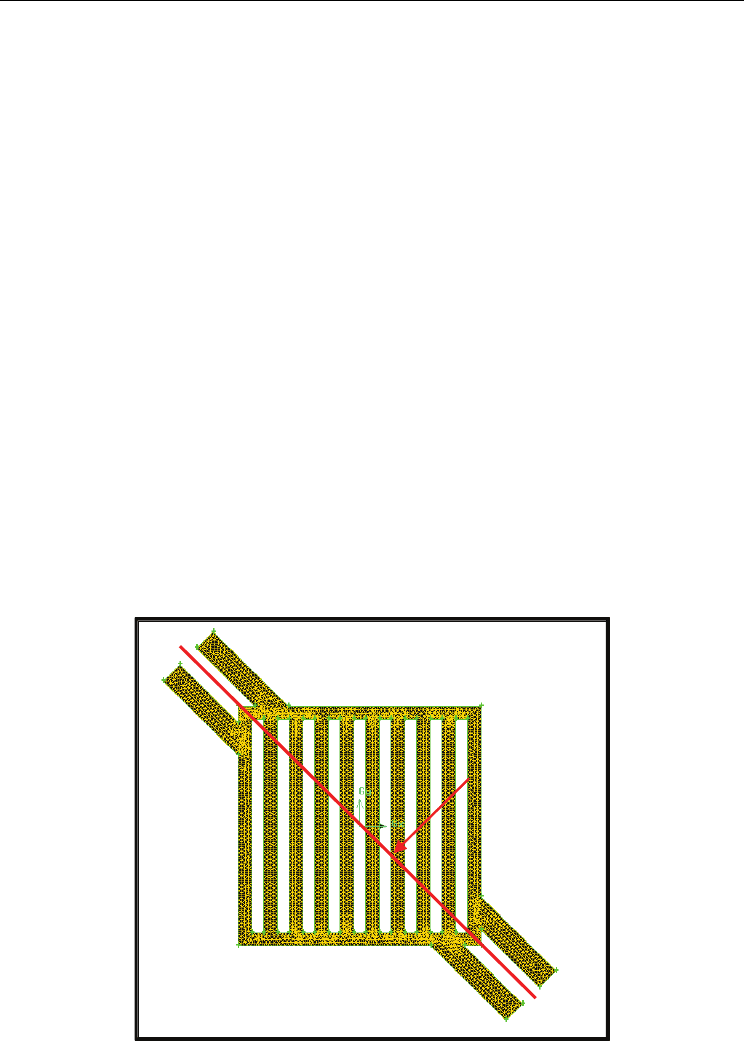
Heat Transfer in Micro Direct Methanol Fuel Cell
489
This capabilities allows that the FLUENT to be used in the wide range in many industries
• Application Process Equipment in chemistry, energy (power), oil, gas,
• Applications of environmental (change climate conditions), air space,
• Turbo machine, car,
• Heat exchangers, electronics (semiconductors and electronic components cooling)
• Air conditioning and refrigeration, process materials and fire investigation and design
architects.
In other words, FLUENT a suitable choice for modeling compressibility and non
compressibility fluid flow can be complex.
7. Numerical analysis of a micro direct methanol fuel cell
7.1 Assumptions for flow and pressure distribution analysis
As was expressed in the anode, reaction begins when produce the
2
CO bubbles, so our
actual flow will be two-phase. According to the process for production parts the surface
quality of spark is not perfectly polished level. The pump flow is completely uniform
because not using a pressure circuit breakers, was not to provide the desired flow.
But in this analysis were the following assumptions:
1. Fluid phase is Single and the gas in the fluid was regardless.
2. Fluid resistance with surface channels was regardless.
3. Inlet flow rate was considered uniform completely.
Full analysis was performed as symmetrical. Therefore, analysis was performed on half the
model. The line of symmetry is aligned with 135 degrees angle line. For network selected
triangular elements and are used 378,640 elements totally in the model. Mesh models is
given in figure (1).
Axisymmetric
line
Fig. 1. Meshing model and axisymmetric line
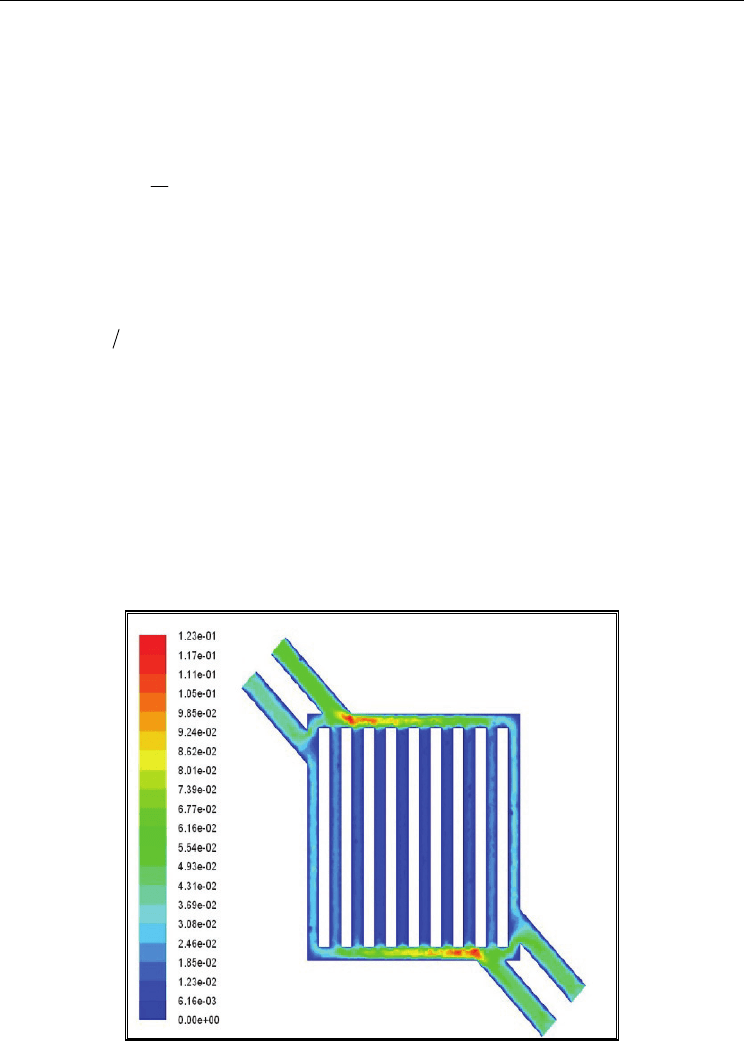
Two Phase Flow, Phase Change and Numerical Modeling
490
For this simulation model is used the second order momentum equation that is given in
formula (4-1) and the momentum coefficient have been used 0.7.
7.2 Momentum equation
The equation is shown in equation (1):
,,
1
().( )
.( .
mm mmm
n
T
mm m m kkdrkdrk
k
t
pgF
ρν ρνν
μν ν ρ αρυυ
=
∂
+∇ =
∂
−∇ + ∇ ∇ + ∇ + + + ∇
(1)
To evaluate the distribution flow in flow field, parallel and cross strip field of this analysis is
given. Figure (2) contour flow distribution in parallel flow channel depth of Z=0.3 and flow
rate
0.3 minmcc=
is shown. Figure (3) contour of the current distribution in the cross strip
flow field is shown. The figure denote uniformity and dispersal distribution cross strip flow
field in comparison with the parallel flow field is much higher and this may seem at first
glance appears one of the important factors in the high efficiency cell that is reactive. If the
path of liquid methanol in the parallel flow field is traced, we observe that the area around
the flow field path and center of flow field have a little velocity. However, if parallel
compared to cross strip flow field, which is observed uniformity in all area of flow field
except in the corner and it shows that in terms of flow field analysis. It can give higher
efficiency compared with parallel the flow field. After simulation, cross strip flow field is
superior to parallel. Figure (4) show flow vector in inlet and Figure (5) show flow vector in
outlet channels cross strip flow field.
Fig. 2. Flow contour in parallel
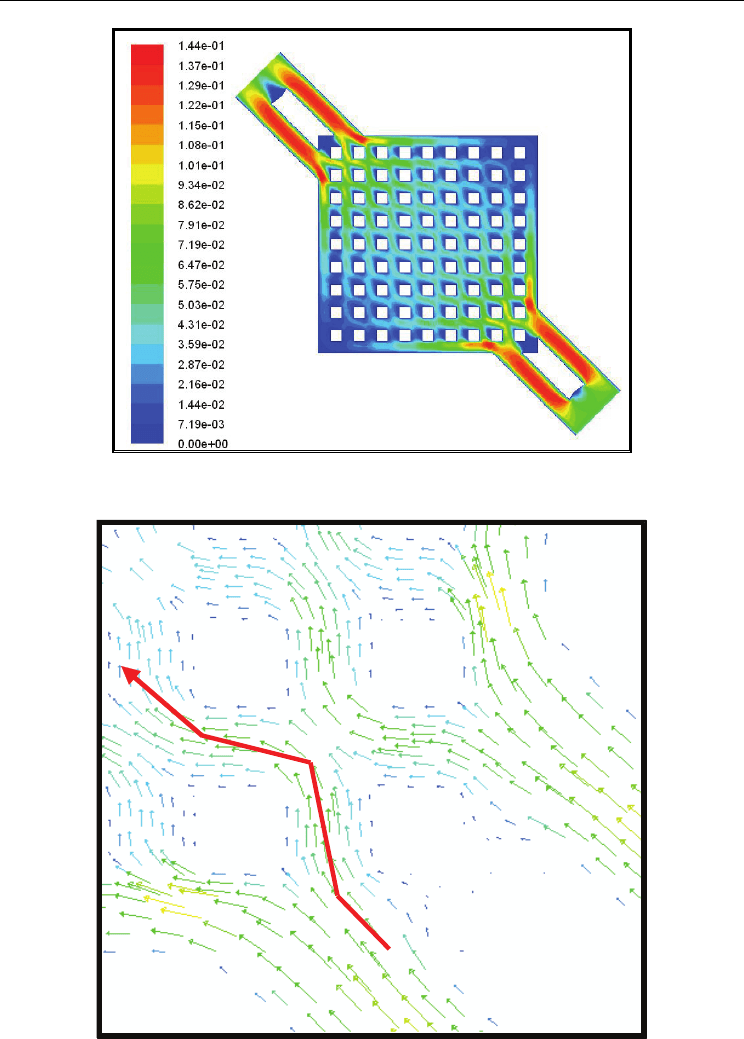
Heat Transfer in Micro Direct Methanol Fuel Cell
491
Fig. 3. Flow contour in cross strip
Fig. 4. Flow of parallel in inlet
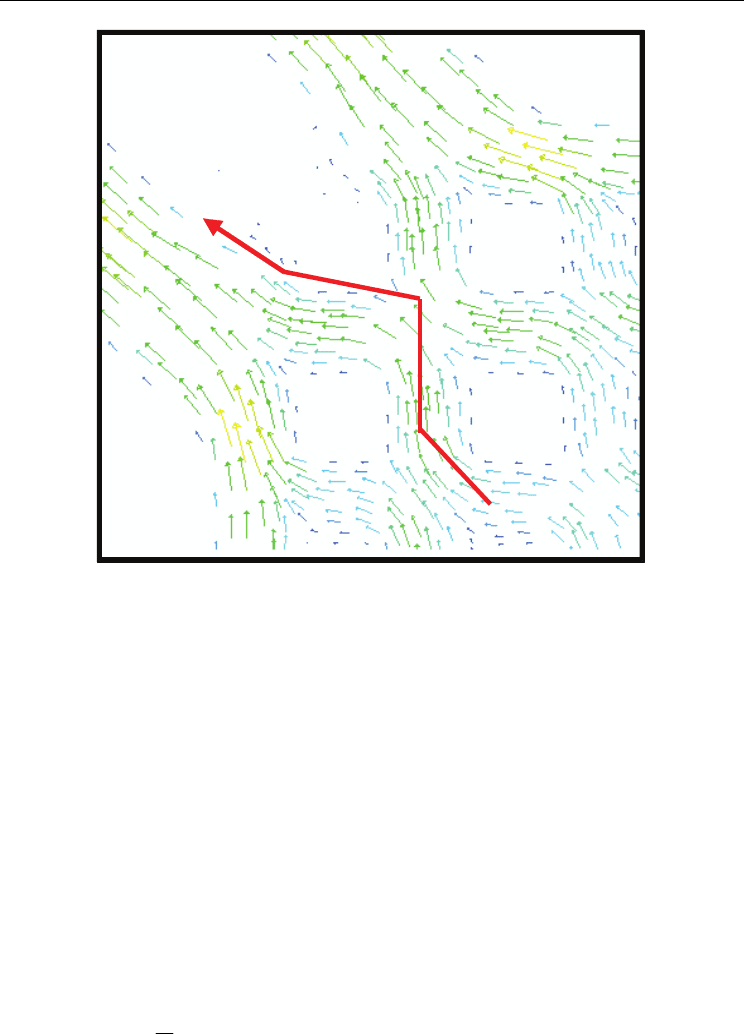
Two Phase Flow, Phase Change and Numerical Modeling
492
Fig. 5. Flow of cross strip in outlet
7.3 Assumptions of heat transfer analysis
In real estate, total area of MEA surface does not participate in chemical reaction uniformly
for this reason that MEA has not a good efficiency and safety of the membrane. In analysis
of thermal conductivity in the steel body of the cell that tried simplifying about reaction in
the cell membrane that is given below:
•
The total membrane surface response to in reaction.
•
The total membrane area reacts in uniformly.
•
There are similar rates of heat generation.
•
The existence of gas bubbles in channels is apart.
Thus, flow is considered as single-phase and slow regimen for fluid motion. Heat
generation is simulated by the MEA with a generation temperature area that total area
generates heat with a constant rate. There for analysis done with these assumptions and use
the energy equation in the calculations.
7.4 Energy equation
The energy equation is defined by below form:
() .(( )) . (.)
e
ff j j
e
ff
h
j
E
p
kT hJ S
t
ρν ν ρ τ ν
∂
+∇ + =∇ ∇ − + +
∂
(2)

Heat Transfer in Micro Direct Methanol Fuel Cell
493
So that
e
ff
k is effective conductivity equal to
t
kk+ that
t
k is thermal conductivity turbulence
and that is defined accord to the turbulence model.
j
J is the gush of components influence.
Three term of Right side of the above equation shows energy transfer due to conduction,
different influence and viscous waste regularity.
h
S is including heat of the chemical reaction or other heat source that is defined. With
simplify the above equations have:
2
2
p
Eh
υ
ρ
=− + (3)
So that h is defined as the sensible enthalpy for ideal gas and that is in the following form:
jj
j
hYh=
(4)
For incompressible fluid we have:
jj
j
p
hYh
ρ
=+
(5)
j
Y is mass fraction of the samples j and
,
ref
T
jpj
T
hcdT=
(6)
So that is 298.15
ref
TK=
. Thermal analysis is applied by using of energy formula for cross
strip flow field for the incompressible fluid that is presented in equation (3). Results are
reported in continue. For analysis, thermal characteristics are given in Table (1).
STEEL-316 METHANOL SOLUTION MATERIAL
8030 785
Density (
3
K
g
/m
)
502.48 2534
Specific heat capacity (
j
/K
g
.k )
16.27 0.2022
Heat transfer coefficient ( W/m.k )
Table 1. Thermal characteristics
After analyzing with the different mass flows (
m
), highest temperature with consideration
by conduction heat transfer from the wall with displacement transfer coefficient
2
10WmKfor air are listed in Table (2). Cell temperature is 300 K
in normal state. The
number of iterations to converge to solutions in Figure (6) is given. Heat transfer contour in
tangent membrane on the page in Figure (7) is shown.
In this analysis, show the effects of the temperature distribution around heat generation
membrane with contours that is specified more clearly with red lines that high light in
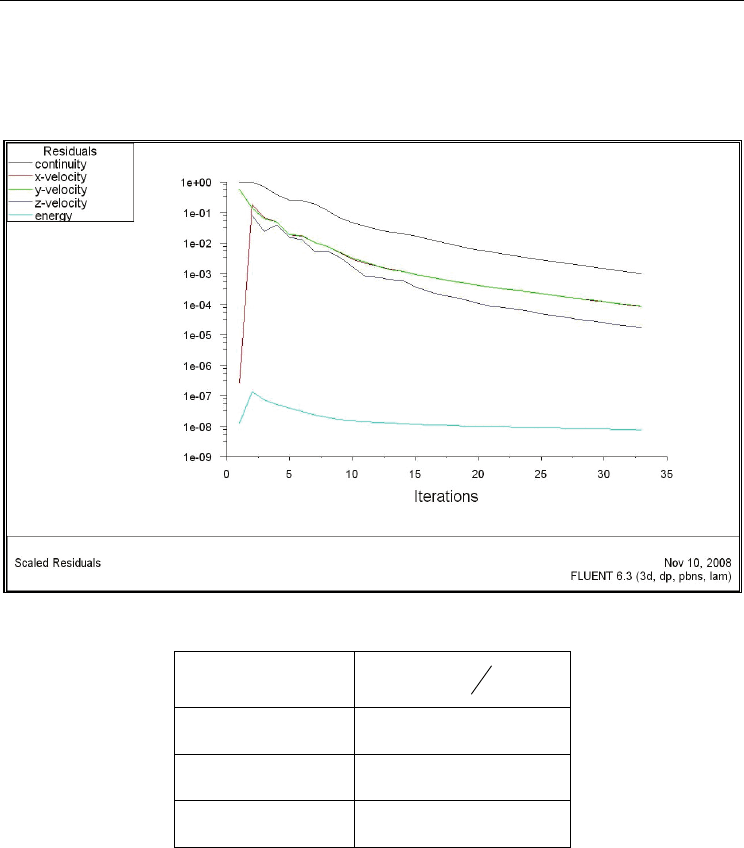
Two Phase Flow, Phase Change and Numerical Modeling
494
figure. The contour dispersals are to output side. This term of view performance is also
acceptable. That is Because of temperature generation and high transfer rate of mass flow in
micro channel that because the temperature contours aggregation in outlet gate and
temperature dispersal in outlet is more that seems quite reasonable.
Fig. 6. Converge to solutions
()
mLit
m
s
max
()TK
0.3 312.5
0.6 310.7
0.9 307.8
Table 2. Highest temperature generate with heat transfer
Figure (8) is shown heat transfer in cross section of steel plate of channel. Following this
study, heat transfer existence in cross is the micro reactor. In this cross section is observed
the temperature gradient contour is put away with a sharp slope relatively. But in
comparison with heat transfer plate mode convention is small relatively. Because
temperature displacement because of mass transfer of micro-channels compared to the
dimensions of micro channels is more effective than heat-conduction in touch with the hot
membrane. High speed of mass transfer in micro channels prevents conduction heat
transfer.
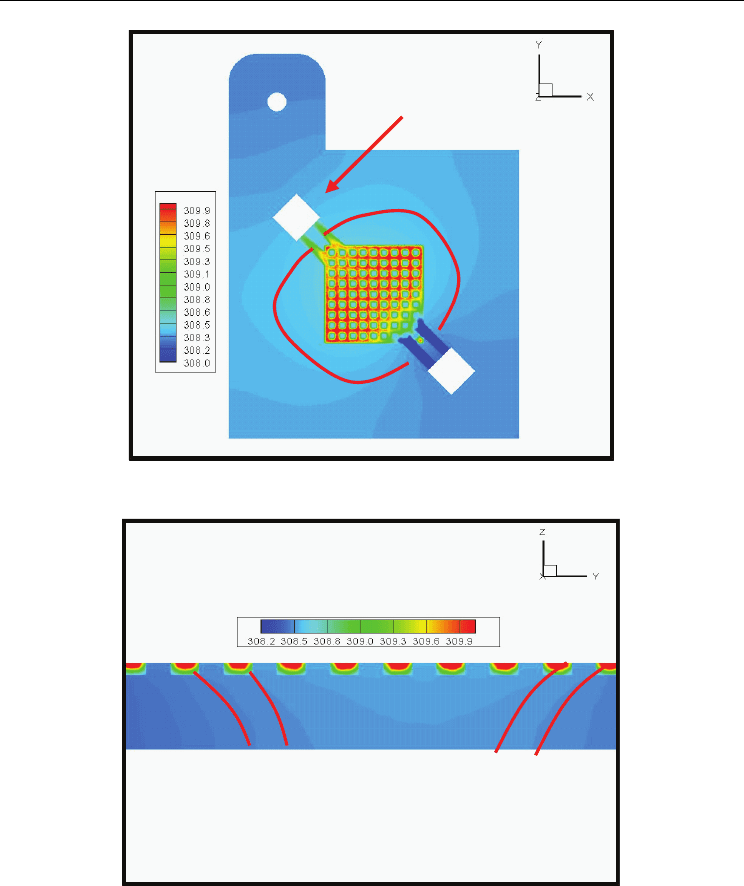
Heat Transfer in Micro Direct Methanol Fuel Cell
495
outlet
Fig. 7. Heat transfer for Steel plate
Fig. 8. Heat transfer of steel cross section plate
8. Conclusion
Performing the numerical simulation can be determined very uniform distribution cross
strip flow field rather than parallel flow field. So with simulation can be determined
distribution of methanol in the membranes. Because if we have good distribution, we have
more uniform fuel distribution in the anode side and result in good performance in reaction.

Two Phase Flow, Phase Change and Numerical Modeling
496
With simulation of heat transfer, is found heat distribution in the cell and can be show the
small scale of the chemical reaction in steel surface areas that are more affected by
temperature, even at very low temperatures different from doing the chemical reaction.
Finally, the comparison between two kind of flow field and give the best distribution in
cross strip flow field and good reaction other than parallel flow field.
9. Acknowledgment
Special thanks for Dr. Shakeri Mohsen and fuel cell research center in Babol university of
mazandaran and all people that assist me in this project.
10. References
Arico, A.S.& Srinivasan S.& Antonucci, V. (2001), 1, No.2. DMFCs, From Fundamental
Aspects to Technology Development, FUEL CELLS.
Cao, J. & Zou, Zh. (2008). Planar air-breathing micro-direct methanol fuel cell stacks based
on micro-electronic–mechanical-system technology. Journal of Power Sources 185
(2008) 433–438.
Kulikovsky, A. (2005). Model of the flow with bubbles in the anode channel and ...
Electrochemistry Communications, 7, pp.237,
Lu, G. Q & Lim, P. C. & Liu, F. Q. & Wang, C. Y. (2005). On mass transport in an air-
breathing DMFC stack. J. Energy Res.; 29:1041–1050.
Lu, G. Q. & Lim, P. C. & Liu, F. Q. & Wang, C. Y. (2005). On mass transport in an air-
breathing DMFC stack. INTERNATIONAL JOURNAL OF ENERGY RESEARCH
Int. J. Energy Res. 2005; 29:1041–1050.
Motokawa, Sh.& Mohamedi, M.& Momma, T.& Shoji, Sh. T. Osaka, (2004). MEMS-based
design and fabrication of a new concept micro direct methanol fuel cell (µDMFC),
Electrochemistry Communications 6 (2004) 562–565.
Valeri, A. D. & Jongkoo L.& Moona, Ch. (2006). Three-dimensional, two-phase, CFD model
for the design of a direct methanol fuel cell, Received 11 April 2006; accepted 26
July 2006.
Van wailer, Thermo dynamic book.
www.fctec.com.
www.fleunt.com.
www.microbialfuelcell.com.
22
Heat Transfer in Complex Fluids
Mehrdad Massoudi
U.S. Department of Energy, National Energy Technology Laboratory (NETL), Pittsburgh
USA
1. Introduction
Amongst the most important constitutive relations in Mechanics, when characterizing the
behaviour of complex materials, one can identify the (Cauchy) stress tensor T, the heat flux
vector q (related to heat conduction) and the radiant heating (related to the radiation term in
the energy equation). Of course, the expression ‘complex materials’ is not new. In fact, at
least since the publication of the paper by Rivlin & Ericksen (1955), who discussed fluids of
complexity n (Truesdell & Noll, 1992)], to the recently published books (Deshpande et al.,
2010), the term complex fluids refers in general to fluid-like materials whose response,
namely the stress tensor, is ‘non-linear’ in some fashion. This non-linearity can manifest
itself in variety of forms such as memory effects, yield stress, creep or relaxation, normal-
stress differences, etc. The emphasis in this chapter, while focusing on the constitutive
modeling of complex fluids, is on granular materials (such as coal) and non-linear fluids
(such as coal-slurries).
One of the main areas of interest in energy related processes, such as power plants,
atomization, alternative fuels, etc., is the use of slurries, specifically coal-water or coal-oil
slurries, as the primary fuel (Papachristodoulou & Trass, 1987; Roh et al., 1995; Tsai & Knell,
1986). Some studies indicate that the viscosity of coal-water mixtures depends not only on
the volume fraction of solids, and the mean size and the size distribution of the coal, but also
on the shear rate, since the slurry behaves as shear-rate dependent fluid (Gupta & Massoudi,
1993). There are also studies which indicate that preheating the fuel results in better
performance (Tsai, et al., 1988; Saeki & Usui, 1995), and as a result of such heating, the
viscosity changes. Constitutive modeling of these non-linear fluids, commonly referred to
as non-Newtonian fluids, has received much attention (Schowalter, 1978; Larson 1999). Most
of the naturally occurring and synthetic fluids are non-linear fluids, for example, polymer
melts, suspensions, blood, coal-water slurries, drilling fluids, mud, etc… It should be noted
that sometimes these fluids show Newtonian (linear) behavior for a given range of
parameters or geometries; there are many empirical or semi-empirical constitutive equations
suggested for these fluids (Massoudi & Vaidya, 2008). There have also been many non-linear
constitutive relations which have been derived based on the techniques of continuum
mechanics (Batra, 2006; Haupt, 2002). The non-linearities oftentimes appear due to higher
gradient terms or time derivatives. When thermal and or chemical effects are also important,
the (coupled) momentum and energy equations can give rise to a variety of interesting
problems, such as instability, for example the phenomenon of double-diffusive convection
in a fluid layer (Straughan, 1998, 2008).

Two Phase Flow, Phase Change and Numerical Modeling
498
When a coal stockpile is stored in the presence of air, slow oxidation of the carbonaceous
materials occurs and heat is released. The self-heating of coal stockpiles has a long history
of posing significant problems to coal producers because it lowers the quality of coal and
may result in hazardous thermal runaway. The prediction of the self-heating process is,
therefore, necessary in order to identify and evaluate control measures and strategies for
safe coal mining, storage and transportation; this requires an accurate estimate of the
various processes associated with the self-heating which are impossible unless the
appropriate phenomenological coefficients are known. In such storage-type problems, the
critical ignition temperature
cr
θ also known as the critical storage temperature, is an
important design and control parameter, since at higher temperatures than this
cr
θ , thermal
ignition occurs, possibly giving rise to a variety of instabilities and problems.
Most complex fluids are multi-component mixtures. In many applications, these fluids are
treated as a single continuum suspension with non-linear material properties and the
techniques and models used in rheology or mechanics of non-linear fluids can generally be
used to study such problems (Larson, 1999). In this case, global or macroscopic information
about the variables such as the velocity or temperature fields for the whole suspension can
be obtained. In many other applications, however, there is a need to know the details of the
field variables such as velocity, concentration, temperature, etc., of each component and in
such cases one needs to resort to the multi-component modeling approaches (Rajagopal &
Tao, 1995; Massoudi, 2008, 2010). Examples of complex fluids whereby both approaches can
be used are coal-slurries, many of the biological fluids such as blood and the synovial fluid,
and many chemically- reacting fluids.
Granular materials exhibit non-linear phenomena like yield stress and normal stress
differences, the latter usually being referred to as dilatancy (Reynolds, 1885, 1886). The
normal-stress phenomenon is a characteristic of non-linear fluids and non-linear elastic
solids. The central role played by this phenomenon in determining the character of granular
materials was recognized early in the development of the theories for modeling granular
materials. Interestingly, a constitutive model that was proposed for wet sand (Reiner, 1945),
enjoyed a good bit of popularity as a model for non-Newtonian fluids before losing its
appeal. One approach in the modeling of granular materials is to treat it as a continuum,
which assumes that the material properties of the ensemble may be represented by
continuous functions so that the medium may be divided infinitely without losing any of its
defining properties. Since granular materials conform to the shape of the vessel containing
them, they can be considered fluid-like. However, unlike fluids, they can be heaped.
Characterizing bulk solids is difficult mainly because small variations in some of the
primary properties such as size, shape, hardness, particle density, and surface roughness
can result in very different behavior. Furthermore, secondary factors (such as the presence
or absence of moisture, and ambient temperature) that are not directly associated with the
particles, but are associated with the environment can have a significant effect on the
behavior of the bulk solids (Massoudi, 2004).
Recently, Mehrabadi et al., (2005) have derived a set of conservation laws and constitutive
relations of a density-gradient-dependent viscous fluid as a multipolar continuum where
the connection between their model and the materials of Korteweg type (Truesdell & Noll,
1992) is also discussed. To replace the classical theory of capillarity, which specifies a jump
condition at the surface separating homogeneous fluids possessing different densities,
Korteweg proposed smooth constitutive equations for the stresses that depend on density
